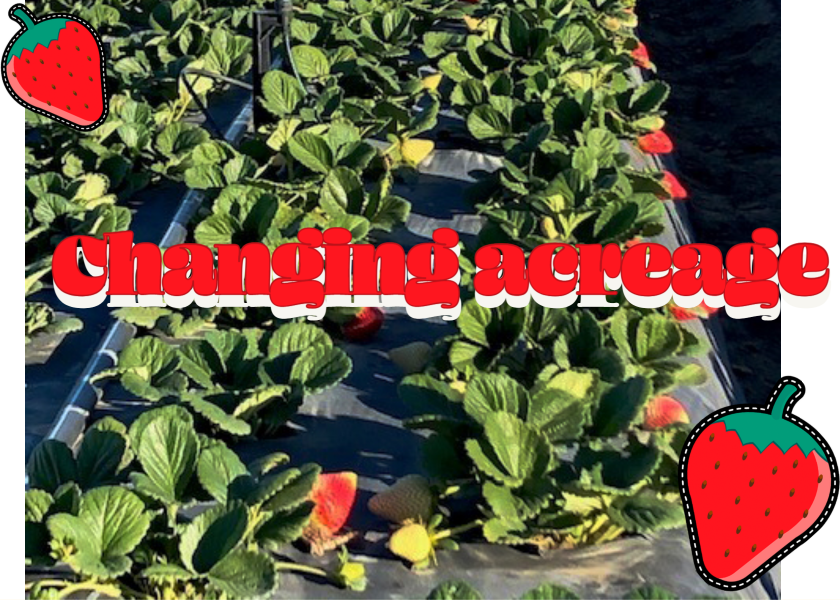Why Southern California's strawberry acreage is slipping

The Southern California strawberry scene has undergone a major transformation during the past couple of decades.
In 1997, the first year for which the Watsonville-based California Strawberry Commission has posted statistics, growers in SoCal — including Oxnard, Orange County, the Coachella Valley and San Diego — planted 7,286 acres of the berries.
Plantings inched upward until the region had 11,615 acres of fall-planted fruit by 2013.
But then, numbers began to slip.
The following year, growers planted only 9,778 acres, and fall-planted acreage for the 2020-21 season is down to 5,863 acres, a jump of about 500 acres over last year, but a far cry from the numbers of a few seasons ago.
Why the drop?
One reason was the introduction of new, high-yielding strawberry varieties that produce more fruit per acre than the old cultivars.
More on SoCal Strawberries: California strawberry supplies tight for Valentine’s Day
There also was somewhat of an oversupply around 2013.
Growers must plant months before the harvest begins and sometimes miscalculate and overplant to account for fruit lost to bad weather or other causes, said Carolyn O’Donnell, communications director for the strawberry commission.
They often react to the oversupply by reducing acreage in subsequent years.
"Co-existing with urban neighbors and navigating the regulatory minefield is an ongoing challenge and can be a moving target."
— Bobby Jones, Bobalu Berries
The skyrocketing costs of land due to housing and commercial development, rising costs for labor and various grower inputs as well as the high cost of increasing government regulation prompted some growers to turn to Mexico as a source for some of their strawberries.
“Leases are still some of the most expensive to be found anywhere in the world,” said A.G. Kawamura, partner in Irvine, Calif.-based Gem-Pack Berries LLC.
New rules on minimum work hours and a rising minimum wage are pushing labor expenses to new highs and driving many producers out of business, he said.
The regulatory environment is another concern.
“Co-existing with urban neighbors and navigating the regulatory minefield is an ongoing challenge and can be a moving target,” said Bobby Jones, managing partner at Oxnard-based Bobalu Berries.
There’s an anti-business environment in California that ignores the needs of agriculture, Kawamura added.
Some growers wanted to move some of their production south of the border to have a back-up supply in case of bad weather in Southern California.
Strawberry acreage in Central Mexico and Baja California rose from 20,814 acres during the 2011-12 season to 32,200 for the current year, according to strawberry commission figures.
A few Orange County growers, displaced by residential and commercial development, picked up acreage in the Santa Maria region, O’Donnell said.
Some of the reduction in winter/spring/summer acreage was countered by an acreage boost during the summer.
Acreage of summer-planted berries for fall production increased by about 1,300 acres over the past decade.
More on SoCal Strawberries: New strawberry varieties in the works for Southern California growers
As a strawberry growing region, Southern California is hard to beat.
“It’s the perfect region for early and high-quality fruit,” Jones said.
Bobalu Berries has grown strawberries in Southern California since 1958.
“We have slowly grown over the years to the acreage we have today and hope to continue to maintain this land into the future,” Jones said.
Because of the mild winters, growers can start harvesting around Christmastime and pick fresh berries until Mother’s Day, he said.
"Leases (in Southern California) are still some of the most expensive to be found anywhere in the world."
— A.G. Kawamura, Gem-Pack Berries LLC
Growers for Gem-Pack have been producing strawberries in Southern California since the late 1940s, Kawamura said.
Its founding program was in Orange County, where the company is the last major strawberry grower-shipper. Gem-Pack also sources from the Oxnard area and has growers in Baja California.
It seems unlikely that Southern California strawberry acreage will undergo a resurgence.
“It may stay consistent for a while and potentially shrink in the future,” Jones said.
Kawamura agreed.
The Southern California strawberry deal likely will continue to shrink because of sheer development pressures in the best growing regions and as a result of increased growing costs, he said.
But he added that there could be some stability as other crops leave the region, new cultivars deliver higher yields and other growing efficiencies help lower input costs.







